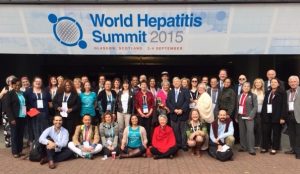
The mood was euphoric. It was a love fest, actually. Last week, more than 600 policy makers, public health experts, and representatives from non-governmental organizations and patient advocacy groups from 80 countries were invited to participate in the first World Hepatitis Summit in Scotland hosted by the World Hepatitis Alliance in partnership with the World Health Organization (WHO). The Hepatitis B Foundation was pleased to be invited and to speak during the pre-summit meeting as well.
The message was serious. Hepatitis B and C kill more people each year than HIV/AIDS and tuberculosis, and combined are the seventh-leading cause of death worldwide, yet viral hepatitis as a global health concern remains mostly invisible and under-funded.
But the focus was on solving the problem, creating solutions. This wasn’t a pity party. Rather, participants were positive that elimination of viral hepatitis is a realistic goal. Policy-makers in attendance are trying to make a difference in their countries, but need more guidance and technical assistance from WHO and other global agencies.
Everyone was in agreement that more must be done. Action is much cheaper than inaction, noted summit speakers. The high economic cost of illness and premature deaths caused by viral hepatitis would be greatly reduced if more effective immunization, screening and treatment programs were available. Without significant intervention, the WHO estimates there will be 20 million needless deaths over the next 15 years around the world.
Hepatitis B affects more than people’s health, noted Joan Block, the foundation’s executive director and cofounder who attended the summit. “It’s also a human rights issue. People don’t want to get tested because they can lose their jobs, and educational and career opportunities,” she said. “People who don’t get tested or treated due to fear of stigma and discrimination cannot access the health care they need, which is a basic human right.”
During the pre-summit meetings, non-governmental organizations (NGOs) and patient advocacy groups shared ideas for increasing awareness and funding to provide more immunization, screening and treatment to the hundreds of millions of people affected by hepatitis B and C. In Ghana, the six hepatitis organizations have created a national coalition and are working with other countries to develop a Pan-African hepatitis coalition. They shared that in Africa, the major obstacle they face is the singular focus on HIV, despite the fact that more people are chronically infected with hepatitis B or C than HIV.
Other groups talked about the importance of sustainability beyond traditional philanthropy and governmental funding. One group in Australia has developed an accredited hepatitis training program on a ‘fee for service’ basis. In Nepal, an organization is bottling and selling water to cover expenses and teach valuable business skills to its clients.
During the official summit, WHO leaders unveiled their draft global viral hepatitis plan, the first of its kind. Its twin goals of reducing chronic viral hepatitis cases by 90 percent and deaths by 65 percent by 2030 are ambitious, but technically possible. If countries make the commitment and investment, WHO believes the global strategy that includes some of the key strategies below will result in success:
Immunize everyone at risk for hepatitis B, including all newborns.
Promote safe and sterile injection practices by healthcare providers and others.
Treat at least 8 million people chronically infected (5 million with hepatitis B and 3 million with hepatitis C).
The WHO plan is being supported by WHO’s Director General Margaret Chan who publicly promised to address viral hepatitis at next year’s World Health Assembly, which will truly be historic..
“We’re ready for a global hepatitis movement,” said Charles Gore, president of the World Hepatitis Alliance, in his opening remarks at the Summit. “We must shift our energies from promoting just one day of awareness — that is, World Hepatitis Day — to creating awareness every day so that we can all live in a world without viral hepatitis.”
With WHO taking a strong leadership position and launching the first global action plan, and more than 200 NGOs and patient advocacy groups dedicated to eliminating viral hepatitis, there is hope that the global pressure will move policy-makers in highly affected countries to make the investment and finally take action to end viral hepatitis.

